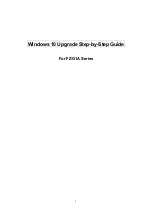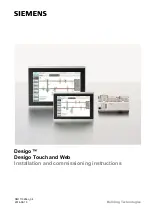
Service modes, fault finding and repair tips
GB 12
FTV1.9DE
5.
5.
Service modes, fault finding and repair tips
For the FTV1.9, the Monitor can be used in two applications.
•
A stand-alone configuration, a separate device which can
also be sold and serviced separately.
•
TV configuration, where the monitor is combined with the
E-box.
The monitor, as a stand-alone unit, can be serviced by using a
test pattern coming from the PDP-LIMESCO panel on the rear
of the monitor itself or via a PC/laptop by using ComPair via the
ComPair connector.
In this chapter the following paragraphs are included:
1.
Test points
2.
Dealer Service Tool (DST)
3.
Service Modes
4.
Error code buffer and error codes
5.
The "blinking LED" procedure
6.
Fault-finding tips
7.
ComPair
5.1
Test points
The FTV1.9 chassis is equipped with test points in the service
printing. These test points are referring to the functional blocks:
•
A1-A2-A3, etc.:
Test points for the Audio amplifier (A)
•
C1-C2-C3, etc.:
Test points for the AV control circuit
(AVC)
•
FD1-FD2-FD3, etc.: Test points for the VsVa supply (FD1-
FD2) and the PDP discharge panel
•
L1-L2-L3, etc.:
Test points for the PDP LIMESCO
(PD1-PD9)
•
PR1-PR2-PR3, etc.: Test points for the Pre-conditioner
(PR1-PR3)
•
Y1-Y2-Y3, etc:
Test points for the Y/C YUV monitor
panel (UY1-YC4)
Measurements are performed under the following conditions:
Video: colour bar signal; Audio: 3 kHz left, 1 kHz right
5.2
Dealer Service Tool (DST)
For easy installation and diagnosis the dealer service tool
(DST) RC7150 can be used. When there is no picture (to
access the error code buffer via the OSD), DST can enable the
functionality of displaying the contents of the entire error code
buffer via the blinking LED procedure, see also paragraph 5.5.
The ordering number of the DST (RC7150) is 4822 218 21232.
5.2.1
Installation features for the dealer
The dealer can use the RC7150 for programming the TV-set
with pre-sets. 10 Different program tables can be programmed
into the DST via a GFL TV-set (downloading from the GFL to
the DST; see GFL service manuals) or by the DST-I (DST
interface; ordering code 4822 218 21277). For explanation of
the installation features of the DST, the directions for use of the
DST are recommended (For the FTV1.9 chassis, download
code 4 should be used).
5.2.2
Diagnose features for service
FTV1.9 sets can be put in two service modes via the RC7150.
These are the Service Default Mode (SDM) and the Service
Alignment Mode (SAM).
5.3
Service Modes
Below described sequence is only valid for the "Monitor Only
Configuration". When a Receiver box is connected to the
Display Box (TV Configuration), please check chapter 5 in the
Training Manual of the Receiver Box.
5.3.1
Service Default Mode (SDM)
The purpose of the SDM is:
•
Provide a situation with predefined settings to get the same
measurements as in this manual.
•
Access to the error buffer via the blinking LED procedure.
•
Inspection of the error buffer.
•
Possibility to overrule software protections via the service
pins (caution: override of software protections! ).
Entering the SDM:
•
By transmitting the "DEFAULT" command with the RC7150
Dealer Service Tool (this works both while the set is in
normal operation mode or in the SAM).
•
By pressing on a standard RC the following sequence 0, 6,
2, 5, 9, 6 followed by the "MENU" key.
•
By short-circuiting the SDM pin on the
µ
P panel.
In the SDM the following information is displayed on the
screen:
--------------------------------------------------------------
F19DBC X.Y_12345 (1) LLLL (2) SDM (3)
ERR 02 01 14 ## ## ## ## ## ## ##
--------------------------------------------------------------
Explanation notes/references:
(1) Software identification of the main micro controller
(F19DBC X.Y_12345)
•
F19D is the chassis name for FTV1.9 display
•
B is the region identification
•
C is the language cluster
•
X = (main version number)
•
Y = (subversion number)
•
##### are 5 digits of the serial number
(2) "LLLL" Normal display operation in hours
(3) "SDM" To indicate that the TV set is in the service default
mode
(4) "ERR 02 01 14 ## ## ## ## ## ## ## ##" This line shows
the contents of the error buffer (max. 10 errors). The last error
that occurred is displayed at the most left position. When less
then 10 errors have occurred the rest of the line is empty. When
the errorlist is empty " No errors" is displayed. No duplicate
errors.
Exit the SDM:
Push the "STANDBY" button on the Remote Control.
The SDM sets the following pre-defined conditions:
•
Volume level is set to 25% (of the maximum volume level).
•
Linear Audio and Video settings are set to 50%.
•
Colour temperature is set to normal.
The following functions are "overruled" in SDM since they
interfere with diagnosing/repairing a set
•
Video blanking.
•
Slow demute.
•
Anti-ageing.
•
Automatic switch to "Standby" when H- and/or V-sync
signals are lost.
All other controls operate normally.
5.3.2
Service Alignment Mode (SAM)
The purpose of the SAM is to align and or adjust settings.
For recognition of the SAM, "SAM" is displayed at the top of the
right side of the screen
Entering the SAM-menu:
•
By pressing the "ALIGN" button on the RC7150 Dealer
Service
•
Standard RC sequence 062596 followed by the "OSD"
button.
www.freeservicemanuals.info
3/2/2013
www.nostatatech.nl
World of free manuals













































